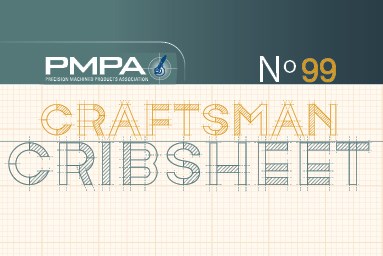Craftsman Cribsheet No. 99: Iron
Iron is, by mass, the most common element on Earth, right in front of oxygen, forming much of the Earth's outer and inner core
#pmpa
Edited by

Carbon may be the most important determinant of a steel’s properties. But without iron there is no steel. No humans, either. Iron is the decay product of Nickel 56, which is the last element produced by nuclear fusion as a star collapses. So, what else should be known about this essential for human life, essential to the precision machining industry, forged in the heart of a dying star’s chemical element?
Iron is Readily Available
- Accounts for about 80% of the Earth’s core.
- Iron is the fourth most common element in the earth’s crust — sixth most common in the universe.
- Iron accounts for 95% of the world’s annual metal production.
- Iron is the second largest commodity market
- after oil.
- If the iron industry was a country, it would have the 24th largest Gross Domestic Product in the world.
- Apparent use per capita in 2019 was just over 504 lbs.
- In-use stocks of steel per capita for developed countries ranges from 11 to 16 tons — 0.2 tons for construction; 1.3 tons for machinery; 1.5 tons for transportation, and 0.6 tons for appliances and containers
- The USGS reported that for 2019, 2,500 million metric tons of iron ore were mined. That same year, 3,200 million metric tons of iron and steel were produced. It is mined in roughly 50 countries.
- Steel (containing iron) comprised 7.2% of all materials landfilled in 2018, a quantity of ~10.5 million tons, according to the U.S. EPA.
- Recycled iron and steel made up 47% of new production through recycling in 2017, according
- to Statista.

Iron can be used in the cast form without alloying to make beautiful and functional objects for our civil infrastructure. (Photo credit: Miles Free III)
Iron Has Useful Properties
- Iron itself is the fifth strongest metal on Earth, behind tungsten(#1). It is the major constituent of the next strongest metal on Earth — steel (#2) and comes in just behind chromium (#3) and titanium (#4)
- When alloyed with carbon and other elements, it can develop a range of mechanical properties which are useful for structural and mechanical properties.
- Ferromagnetism is an important aspect of current technology and is estimated to be responsible for about 1% of Gross National Product. (Data recording such as audio tapes and hard disk drives are typical applications that rely on the magnetic response of iron to magnetic fields. Solenoids are mechanical devices that use magnetism to operate.)
RELATED CONTENT
-
How Do We Fix American Manufacturing?
In America, many have lost sight of the fact that the object of the act of manufacturing is not merely the generation of maximum profit, but instead the creation of value.
-
SWOT for Employee Retention and Recruitment
What is your brand? Why should people want to work for your company? How can your brand improve? A SWOT analysis can help answer these questions — your employee retention and recruitment may count on it.
-
Precision Machining Jobs Account for 7 of the Top 25 High Paying Jobs — No College Degree Required
Those who hire in the precision machining industry have a persuasive point for prospective employees who don’t hold — or want to go into debt to hold — a college degree.


